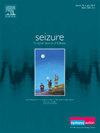Brivaracetam use in children with epilepsy: A retrospective multicenter study
IF 2.7
3区 医学
Q2 CLINICAL NEUROLOGY
引用次数: 0
Abstract
Purpose
This retrospective multicenter study aimed to assess the efficacy and safety of brivaracetam (BRV) in pediatric epilepsy.
Methods
Our cohort consisted of 93 children (mean age 11.5 ± 7.5 years) with a wide spectrum of pediatric epilepsy, including epileptic encephalopathy and generalized epilepsy. Of these, 61 (60.4%) were diagnosed with focal epilepsy, 19 (15.8%) with generalized epilepsy, and 16 (15.8%) with combined epilepsy, while 8 patients (7.9%) had an unknown epilepsy type. The cohort included rare epilepsy syndromes: 8 patients with Lennox-Gastaut syndrome, 3 with Dravet syndrome, and 1 with Rasmussen syndrome. Patients had a history of various antiseizure medications (ASMs) (6.42 ± 3.15), and on average, were being treated with more than two (2.57 ± 1.16) drugs at the time of BRV deployment.
Results
Retention rates were high, with 80.6% of patients adhering to treatment at 3 months, 66.7% at 6 months, and 45.2% at 12 months. In 29 patients (30.1%), BRV was added in an overnight switch from levetiracetam (LEV), resulting in a reduction of behavioral adverse effects (AEs) in 5 patients (17.2%). The response rate was 25.8% at 3 months, 16.1% at 6 months, and 17.2% at 12 months, with no responders in the epileptic encephalopathy group. Therapy tolerance was notable, with 70 patients (75.3%) reporting no AEs. Transient AEs occurred in 10 patients (10.7%), and in 13 cases (14.0%), the AEs warranted dose adjustment or discontinuation of BRV.
Conclusion
Approximately one-fifth of pediatric patients with drug-resistant epilepsy responded to BRV, with the best response observed in patients with focal seizures. However, the impact on patients with epileptic encephalopathy was limited.
在儿童癫痫患者中使用溴伐巴坦:一项回顾性多中心研究。
目的:这项回顾性多中心研究旨在评估溴伐他西泮 (BRV) 治疗小儿癫痫的疗效和安全性:我们的队列由 93 名儿童组成(平均年龄为 11.5 ± 7.5 岁),他们患有各种类型的小儿癫痫,包括癫痫性脑病和全身性癫痫。其中,61 名儿童(60.4%)被诊断为局灶性癫痫,19 名儿童(15.8%)被诊断为全身性癫痫,16 名儿童(15.8%)被诊断为合并癫痫,8 名儿童(7.9%)癫痫类型不明。队列中包括罕见的癫痫综合征:8名患者患有伦诺克斯-加斯陶特综合征,3名患者患有德拉沃综合征,1名患者患有拉斯穆森综合征。患者有各种抗癫痫药物(ASMs)病史(6.42 ± 3.15),在部署 BRV 时平均正在接受两种以上(2.57 ± 1.16)药物的治疗:保留率很高,80.6%的患者在 3 个月后坚持治疗,66.7%的患者在 6 个月后坚持治疗,45.2%的患者在 12 个月后坚持治疗。29名患者(30.1%)在一夜之间从左乙拉西坦(LEV)转为使用BRV,结果5名患者(17.2%)的行为不良反应(AEs)有所减少。3个月时的应答率为25.8%,6个月时为16.1%,12个月时为17.2%,癫痫性脑病组无应答者。治疗耐受性良好,70 名患者(75.3%)未报告任何不良反应。10名患者(10.7%)出现了短暂的不良反应,13名患者(14.0%)因不良反应而需要调整剂量或停用BRV:结论:约五分之一的耐药性癫痫儿童患者对BRV有反应,局灶性癫痫发作患者的反应最好。但对癫痫性脑病患者的影响有限。
本文章由计算机程序翻译,如有差异,请以英文原文为准。
求助全文
约1分钟内获得全文
求助全文
来源期刊

Seizure-European Journal of Epilepsy
医学-临床神经学
CiteScore
5.60
自引率
6.70%
发文量
231
审稿时长
34 days
期刊介绍:
Seizure - European Journal of Epilepsy is an international journal owned by Epilepsy Action (the largest member led epilepsy organisation in the UK). It provides a forum for papers on all topics related to epilepsy and seizure disorders.
 求助内容:
求助内容: 应助结果提醒方式:
应助结果提醒方式:


